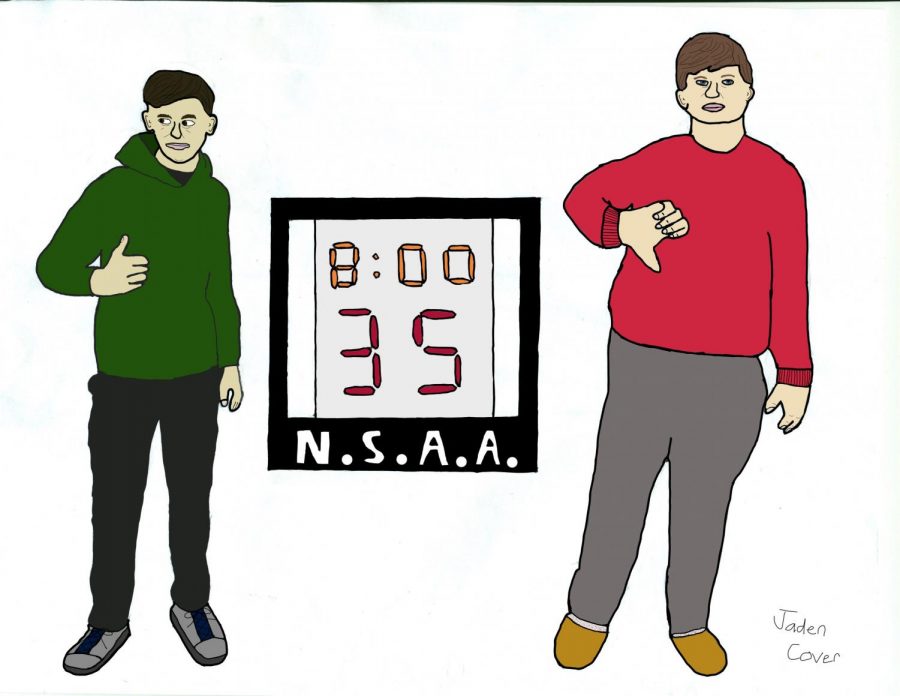Shooting down the shot clock
February 28, 2018
Rushing through sloppy possession after sloppy possession with a lack of passing just to beat the clock. Erred passes off of a double teams and turnover after turnover.
This is what high school basketball could turn into with an addition of a shot clock.
High school basketball is predicated on ball movement and ball control. Defenses are forced to be aggressive when down in games, and cannot lean on a shot clock to get them the ball back. The man-to-man style forced upon the defenders teaches players how to press effectively.
Basketball is not the only sport where teams can play “keep away” late in games to prevent the other team’s offense from becoming a factor. In football, a team can run the ball or take a knee to burn the clock and prevent a turnover. Soccer players will clear the ball to flip fields and stall play when up late in games. It isn’t cheap or unsportsmanlike, it is strategy, and a true testament to the discipline of a coaching staff and its players.
If a basketball team is able to control the ball for minutes at a time, it is more impressive than anything. A defense can foul or trap their opponents if they feel they are stalling or not making an attempt to score. The defending team should not be aided by a shot clock in high school basketball.
Theoretically, if a mandatory shot clock became a requirement by the Nebraska Schools Activities Association (NSAA), the cost would take a hit on many school districts. The lowest amount paid for a mounted shot clock is $5,000 according to Mike Sautter, writer for the Omaha World Herald. This amount does not include electrical, running wiring and mounting the shot clock to the backboard. Also, for schools like Millard West who boast nine total basketball teams ranging from freshman to varsity for both boys and girls, there are often games going on in both gymnasiums. Because of this, West would have to set up two shot clock systems, an investment well over $10,000.
There are 281 schools in Nebraska that participate in basketball. All of these schools would have to mount a shot clock on their backboards if the NSAA ever decided to make a shot clock mandatory. Assuming all schools spent around $7,000 due to the cost of hiring professionals to mount it along with the initial price tag, the total for all 281 schools is around two million dollars.
“With the number of small schools, cost will be a fight,” Millard West Coach Bill Morrison said. He would not be surprised to see a shot clock appear in Class A games in the future, but as far as the other classes, he thinks it would be a struggle.
Morrison likes the idea of a shot clock for late quarter “two and one” scenarios, but he does not think the shot clock will be a factor most possessions.
“I think it would improve the game, but not many possessions last longer than 35-40 seconds,” Morrison said.
The issue is the initial statewide cost of nearly two million dollars is not worth the last two to three possessions in a quarter. Especially since the money for the shot clock is coming from Nebraskan taxpayers who will likely not be in support of shelling out money for an unnecessary commodity. Not to mention, there will undoubtedly be an annual cost on the schools because they have to find teacher to operate the shot clock. Teachers who the run scorer’s tables in most districts are given extra pay or are stipend for the extra work. Operating a shot clock would be no different. The average pay for a teacher operating at a scorer’s table is between $25-45 per game. Even if Millard West only pays their teachers $25 a game, that is $550 for just the girls and boys varsity home games throughout the season. There are still seven other squads that will have to play home games at Millard West. A shot clock is not only a $10,000 initial investment for Millard West, but it is an annual investment of thousands of dollars.
People only want the shot clock to avoid teams running out the clock late in games. It is where the most complaints occur, but the complaints are not worth Nebraska schools paying nearly two million dollars all together to change the rules. High school basketball is not broken. It is still thriving as the second most attended high school sport in Nebraska behind football. Keep the game the same and save some cash.






